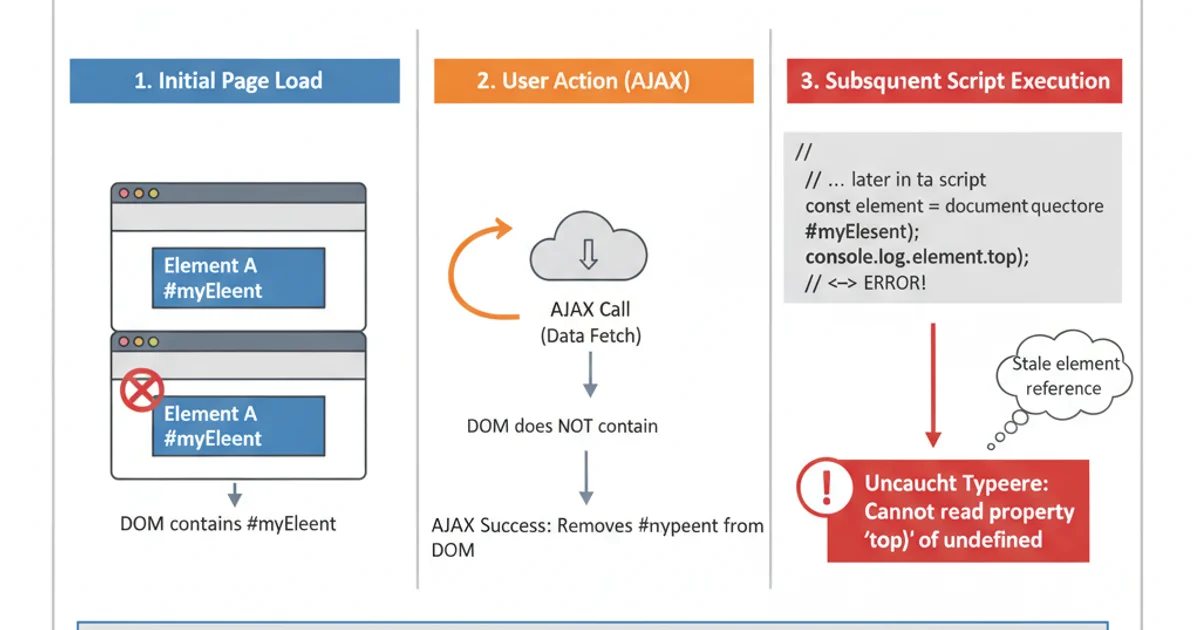Uncaught TypeError: Cannot read property 'top' of undefined
Categories:
Debugging 'Uncaught TypeError: Cannot read property 'top' of undefined' in JavaScript

This article provides a comprehensive guide to understanding, diagnosing, and resolving the common JavaScript error "Uncaught TypeError: Cannot read property 'top' of undefined," often encountered in jQuery or DOM manipulation.
The error Uncaught TypeError: Cannot read property 'top' of undefined is a frequent stumbling block for JavaScript developers, especially when working with jQuery or directly manipulating the Document Object Model (DOM). This error typically indicates that you are attempting to access a property (like top) on a variable or object that does not exist or has not been properly initialized, resulting in an undefined value. Understanding its root causes and common scenarios is crucial for effective debugging.
Understanding the 'Undefined' Context
At its core, this error means that the JavaScript engine tried to read the property top from something that evaluated to undefined. In the context of web development, this 'something' is almost always a DOM element or a jQuery object that you expected to exist but didn't. This can happen for several reasons, such as incorrect selectors, elements not yet loaded, or operations on elements that have been removed from the DOM.
flowchart TD
A[Code attempts to access property 'top'] --> B{Is the target object 'undefined'?}
B -- Yes --> C["Uncaught TypeError: Cannot read property 'top' of undefined"]
B -- No --> D[Property 'top' accessed successfully]
C --> E[Debugging: Why is the object 'undefined'?]
E --> F{Incorrect Selector?}
E --> G{DOM Not Ready?}
E --> H{Element Removed?}
E --> I{Typo in Variable Name?}
F --> J[Check selector syntax and element existence]
G --> K[Wrap code in `$(document).ready()` or `DOMContentLoaded`]
H --> L[Verify element's lifecycle]
I --> M[Double-check variable spelling and scope]Flowchart illustrating the cause and debugging paths for 'Cannot read property 'top' of undefined'.
Common Causes and Solutions
Let's explore the most common scenarios that lead to this error and how to effectively resolve them. Identifying the exact point where the undefined value originates is the first step towards a fix.
1. Element Not Found by Selector
This is perhaps the most common reason. If your jQuery selector (e.g., $('#myElement')) or native DOM method (e.g., document.getElementById('myElement')) fails to find an element, it will return an empty jQuery object or null respectively. If you then try to access a property like position().top on an empty jQuery object, or style.top on a null element, you'll get this error.
// Incorrect selector - element with ID 'nonExistent' does not exist
var element = $('#nonExistent');
// This will throw 'Uncaught TypeError: Cannot read property 'top' of undefined'
// because element.position() returns undefined for an empty jQuery object.
var topPosition = element.position().top;
// Native JavaScript equivalent
var nativeElement = document.getElementById('nonExistent');
// This will throw 'Uncaught TypeError: Cannot read property 'top' of undefined'
// because nativeElement is null, and null.style is an error.
// var topStyle = nativeElement.style.top; // This specific line would be 'Cannot read property 'style' of null'
// However, if you had a chain like nativeElement.getBoundingClientRect().top, and nativeElement was null, it would be 'Cannot read property 'getBoundingClientRect' of null'
// The principle remains: accessing a property on a non-existent object.
Example of an element not found, leading to 'undefined'.
element.length > 0. For native DOM, check if the variable is not null.// jQuery: Check if element exists
var element = $('#myElement');
if (element.length > 0) {
var topPosition = element.position().top;
console.log('Top position:', topPosition);
} else {
console.warn('Element #myElement not found.');
}
// Native JavaScript: Check if element exists
var nativeElement = document.getElementById('myElement');
if (nativeElement) {
var topPosition = nativeElement.getBoundingClientRect().top;
console.log('Top position:', topPosition);
} else {
console.warn('Element #myElement not found.');
}
Safely accessing properties after checking for element existence.
2. DOM Not Fully Loaded
If your JavaScript code attempts to access DOM elements before the HTML document has been fully parsed and rendered, those elements might not yet exist in the DOM tree. This is a common issue when <script> tags are placed in the <head> section without proper deferral mechanisms.
<!-- HTML -->
<head>
<script>
// This script runs before <div id="myElement"> is parsed
var element = document.getElementById('myElement');
// element will be null here, leading to error if you try to access properties
// var topPosition = element.getBoundingClientRect().top; // Error!
</script>
</head>
<body>
<div id="myElement">Hello</div>
</body>
Script attempting to access DOM before it's ready.
<script> tags just before the closing </body> tag, or wrap your DOM manipulation code in a DOMContentLoaded event listener (native JS) or $(document).ready() (jQuery).// jQuery approach
$(document).ready(function() {
var element = $('#myElement');
if (element.length > 0) {
var topPosition = element.position().top;
console.log('Top position (jQuery):', topPosition);
}
});
// Native JavaScript approach
document.addEventListener('DOMContentLoaded', function() {
var element = document.getElementById('myElement');
if (element) {
var topPosition = element.getBoundingClientRect().top;
console.log('Top position (Native JS):', topPosition);
}
});
Ensuring DOM is ready before manipulation.
3. Element Removed or Replaced Dynamically
In single-page applications or highly dynamic interfaces, elements can be added, removed, or replaced on the fly. If you store a reference to an element and then that element is removed from the DOM, your stored reference might become 'stale' or point to an element that no longer has the expected properties or is no longer part of the document flow.

Dynamic DOM changes can lead to stale element references.
4. Incorrect jQuery Method Usage
The error Cannot read property 'top' of undefined often specifically points to jQuery's position() or offset() methods. These methods return an object with top and left properties. If the jQuery object you call position() on is empty (i.e., no elements were found by the selector), position() will return undefined, and attempting to access .top on undefined will cause the error.
// This is the classic scenario for the error:
var $nonExistentDiv = $('#i-dont-exist');
// $nonExistentDiv is an empty jQuery object.
// Calling .position() on an empty jQuery object returns undefined.
var pos = $nonExistentDiv.position(); // pos is now undefined
var topValue = pos.top; // ERROR: Cannot read property 'top' of undefined
Demonstration of position() returning undefined for an empty jQuery object.
1. Verify Element Existence
Before calling .position() or .offset(), always check if your jQuery selector returned any elements using $(selector).length > 0.
2. Inspect Selector
Double-check your selector string for typos, correct IDs, classes, or attribute values. Use console.log($('#yourId')) to see if it returns a jQuery object with elements.
3. Ensure DOM Readiness
Wrap your code in $(document).ready(function() { ... }); to guarantee that all elements are available when your script runs.
4. Check for Dynamic Changes
If elements are added/removed dynamically, ensure your code re-selects the element or uses event delegation if applicable.